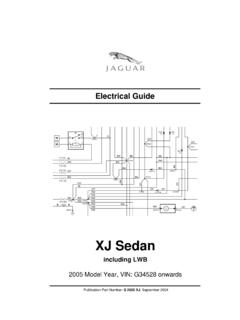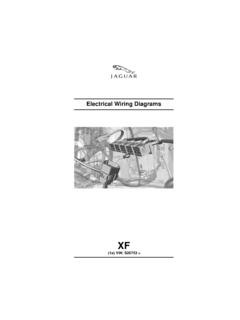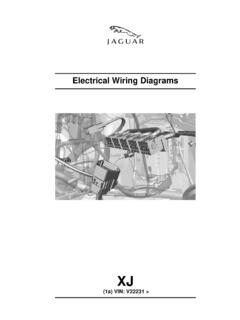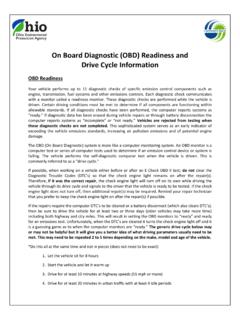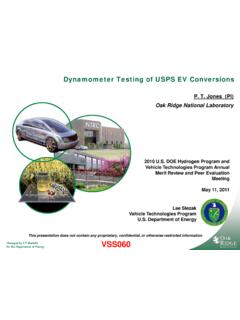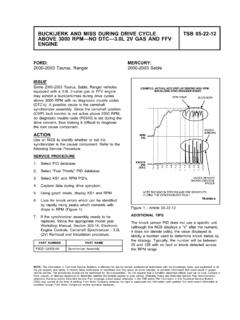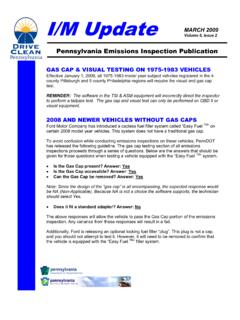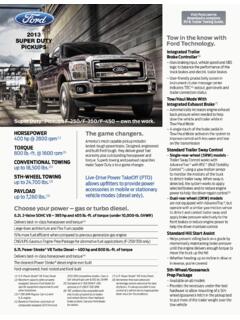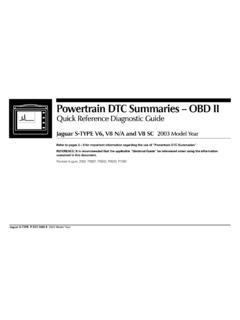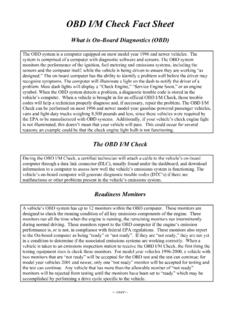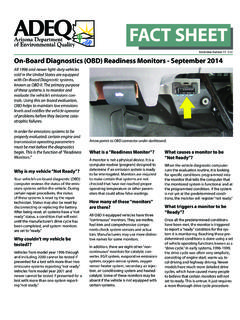Transcription of EVAP - Jaguar Repair Information Resource
1 16|Motor AgeJanuary 2005 HOW ford , GM AND CHRYSLER ENHANCED ON-BOARD evap MONITORS WORK IS JUST AS IMPORTANT AS USINGTHE PROPER TOOLS TO TROUBLESHOOT JACQUES GORDON, TECHNICAL EDITORIN THE NEWEST GENERATION OF ENHANCED EVAPORATIVE EMISSION CONTROLS, THE PCM CAN MONITOREVERY COMPONENT AND FUNCTION OF THE EVAPORATIVE EMISSION ( evap ) SYSTEM. THIS IS GOOD NEWS,BECAUSE IT MEANS THE POWERTRAIN CONTROL MODULE (PCM) CAN PROVIDE USEFUL DIAGNOSTICINFORMATION FOR WHAT MAY BE THE MOST DIFFICULT SYSTEM TO TROUBLESHOOT.
2 EVEN BETTER, NOW THERE IS A SERVICE PORT THAT MAKES IT EASIER TO SEARCH FOR LEAKS USING SMOKE. BUT IN ADDITIONTO TOOLS AND TRAINING, TROUBLESHOOTING evap CODES ALSO REQUIRES AN UNDERSTANDING OF HOW THESYSTEM IS SUPPOSED TO WORK. SO HERE GOES ..BACKGROUNDThe enhanced evaporative emission control system is aresult of California emissions regulations that went intoeffect for the 2000 model year. Most new vehicles sold in all50 states met those requirements that first year, and todaythey all do. You can tell the difference by looking for a serv-ice port cap under the hood, sometimes marked evap .
3 Like the earlier systems, the enhanced evap system cap-tures fuel tank vapors and sends them to be burned in theengine. The two enhancements refer to the on-boarddiagnostic (OBD) system s ability to detect leaks as small of an inch ( ) and to monitor canister purgeflow. The former is required by law to monitor the health ofthe evap system,and the later is needed by the PCM tocontrol tailpipe emissions and preserve driveability duringcanister purge. There are several different ways to accom-plish these tasks,and of course the automakers have usedthem , they re not hard to understand.
4 For Client ReviewOnly. All Rights Reserved. Advanstar Communications Inc. 2005 FFor Client ReviewOnly. All Rights Reserved. Advanstar Communications Inc. 2005 FThere are two different ways for anOBD system to leak test an enhancedEVAP system: pressurize it or put itunder vacuum. Each has its advan-tages. Vacuum testing is mechanicallysimpler, requiring only two solenoidvalves and a fuel tank absolute-pres-sure sensor. But because the vacuumcomes from the intake manifold, thedrive cycle (the engine operating con-ditions needed for the test) is very pre-cise, so there s no guarantee the testwill actually run during any given with pressure requiresa pump and extra plumbing, but thedrive cycle is less exacting.
5 FordMotor Co., General Motors (GM) andsome Asian models use vacuum tests,while DaimlerChrysler, some Asianand most European models use pres-sure either case, leak testing an evap system requires sealing the system ateach purge control solenoidvalve is used to seal the system at theintake manifold end, and another sole-noid valve seals the canister s fresh canister vent valve is nor-mally open,and on several models aclogged fresh air inlet has caused problems that turn on themalfunction indicator lamp (MIL), but more on that TESTINGThe vacuum leak test used by ford and GM has twophases large-leak and small-leak detection.
6 In both phases,the PCM will close the vent valve, pulse the purge valve todraw a vacuum on the system and monitor a pressure/vacu-um sensor in the fuel tank. The PCM is looking for howquickly the vacuum builds to a predetermined level, andthen with both valves closed, how quickly it decays. Thebasic difference between the large- and small-leak tests is theamount of time for the test, and, of course, different algo-rithms are used to calculate the all the enable criteria have been met, the firststep in the test is to calculate how much fuel vapor is beinggenerated in the tank.
7 The PCM does this by closing boththe purge and vent valves and looking at the tank pressuresensor. If the rate of vapor generation (tank pressure rise) istoo great, the PCM may draw a slight vacuum on the tankand/or purge the system to precondition it, and thencheck the PCM still thinks fuel tank vapor pressureis rising too quickly for a valid test, it will abort the with fuel sloshing and heat, vacuum in the fueltank makes fuel evaporate, so the deepest vacuum draw israrely more than 10 inches of water. The PCM may abortthe test if fuel tank pressure changes by only 1 inch of waterduring the vapor check.
8 It takes more pressure than that toblow out a for such small changes requiresvery stable vehicle operating conditions, aka enabling con-ditions,which is why the small-leak test ( inch leak) isso difficult for the PCM to each model of car has very specific test require-ments, the following enabling conditions will give you anidea of how the PCM uses vacuum to leak-test the evap system. These are general enabling criteria; they are not acomplete list of what is needed to actually run the test: The PCM needs to know fuel unlessthere is a fuel tank temperature sensor, the test runs aftercold-start when the coolant temperature is near ambient,indicating the engine has not been running for a long periodof time and returning warm fuel to the tank.
9 The test requires a steady speed and load s first small-leak test and ford s small-leak validation(second) test require the engine to be at idle with zero ornear-zero vehicle speed. The idea is to test with steady man-ifold vacuum and no fuel tank sloshing. Ambient temperaturemust be between 40 F and100 F so the fuel tank vapor pressure remains stable duringthe test. On some models, the upper limit is only 86 F. Fuel levelmust be between 15 percent and 85 percent,and the PCM must be getting a stable signal from the tankFord and General Motors evap systems have a similar layout.
10 In this Fordschematic, the purge valve is called the Vapor Management :Michael : ford Motor January 2005 Motor Age|17 VAPOR MANAGEMENT VALVE(NORMALLY CLOSED)CONTROLVACUUM SOURCEINTAKEMANIFOLDENGINEWIRES FROM PCMPCMFUEL TANKFUEL TANK PRESSURE SENSOREVAP CANISTEREVAP CANISTERVENT SOLENOID(NORMALLY OPEN)FROM ATMOSPHERE18|Motor AgeJanuary 2005 Illustration: Michael Stassus. Source: DaimlerChryslerlevel sender so it can calculate how long itshould take for vacuum to build and decay. Onsome models, if fuel level increases betweenengine starts or while the engine is running,which indicates the vehicle has been refueled, itmay run a large-leak test right away to see if thefiller cap has been tightened properly.


